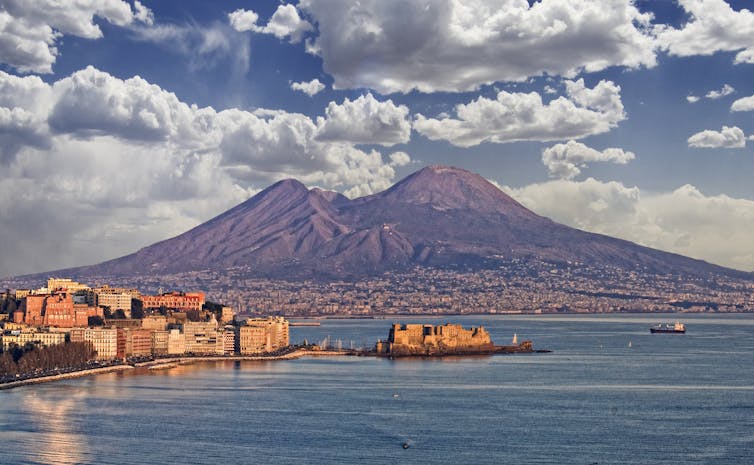

Curious Kids is a series for children of all ages. If you have a question you’d like an expert to answer, send it to curiouskidsus@theconversation.com.
What causes volcanoes to erupt? – Avery, age 8, Los Angeles
On Nov. 27, 2022, Mauna Loa – the world’s largest active volcano – erupted on the island of Hawaii. For days, fountains of lava, boiling at more than 2,000 degrees Fahrenheit (1,100 degrees Celsius), spewed upward and flowed down the mountain’s sides.
For tens of millions of people around the world, the videos were a mesmerizing sight. Then, a few weeks later, the eruption ended. Fortunately, there were no known deaths, and no major property damage.
About a week later, Mount Semeru in East Java, Indonesia, erupted a mix of ash, gas and hot rocks. The plumes rose a mile above the mountain’s summit. Thousands living in the vicinity were evacuated; many wore masks to protect themselves from the ash-filled air. Mount Semeru has continued to erupt for months.
I am a geologist who studies minerals in volcanic rocks. I want to learn more about what causes volcanoes to erupt. Millions of people live near an active volcano – that is, one of the 1,328 volcanoes worldwide that have erupted over the past 12,000 years.
At any given time, 20 to 50 of these active volcanoes are erupting. The proximity of people and buildings makes it important to study volcanoes and understand the hazards.

How volcanoes blow their stacks
The center of the Earth is called the core; the next layer up is the mantle; the outermost layer is the crust.
Over time, magma – which is melted rock mixed with gas and mineral crystals – accumulates in an underground chamber beneath the volcano. The magma at Mauna Loa forms when a hot mantle plume – think of a conveyor of heat – partly melts rock in the mantle.
The volcano is essentially an opening that lets magma out onto the surface of the Earth. Once released from the volcano, the magma is called lava.
In the months leading to its eruption, scientists noted increased earthquakes and a bulging of Mauna Loa, like a balloon being inflated. These signs suggested that more magma was making its way upward, because pressure from rising magma can expand the sides of a volcano and cause rocks to shift and break, which leads to earthquakes.
Typically, for an eruption to occur, enough magma must accumulate in the chamber under the volcano. Then something needs to trigger the eruption. That could be an injection of new magma into the chamber, a buildup of gases within the volcano, or a landslide that removes material from the top of a volcano.
Types of volcanoes
Mauna Loa is a shield volcano, built up over thousands of years through lava eruptions. Its sides slope gently downward in all directions.
But Mount Semeru is different – it’s a composite volcano, also known as a stratovolcano, with steep sides that come to a point at the top, like an upside-down sugar cone.
Semeru’s most recent eruption started when heavy rains washed away rocks near the top of the volcano. That allowed gas to escape – and ash to start erupting.

The dangers
Many hazards are associated with erupting volcanoes: lava flows, acidic gases, ash and lahars, which are dangerous flows of water, ash and rock that run miles down the steep slopes of volcanoes, sometimes at over 100 miles per hour. The force of lahars can move huge boulders and destroy bridges and buildings.
Mount Semeru’s recent eruption covered nearby villages with ash – tiny particles of rock that can go deep into lungs, causing irritation and making it hard to breathe.
As falling ash accumulates, it can smother crops, contaminate water supplies and trigger the collapse of buildings. Newly fallen dry ash weighs 10 to 20 times more than snow.
Generally, scientists don’t try to stop volcanoes from erupting. They are a natural part of the Earth. But monitoring volcanoes is critical. People need an early warning of an eruption so they can move out of harm’s way.
While we cannot predict the exact time of an eruption, scientists are learning more about what causes them, and how to protect people who live near them.
What’s critical: warning systems for lahars, planned evacuation routes in areas threatened by volcanoes, and excellent communication between the scientists at volcanic monitoring stations and government agencies who can let people know when a volcano is about to go.
Hello, curious kids! Do you have a question you’d like an expert to answer? Ask an adult to send your question to CuriousKidsUS@theconversation.com. Please tell us your name, age and the city where you live.
And since curiosity has no age limit – adults, let us know what you’re wondering, too. We won’t be able to answer every question, but we will do our best.
Rachel Beane receives funding from Bowdoin College and the National Science Foundation. She is affiliated with the Harpswell Heritage Land Trust.
This article was originally published on The Conversation. Read the original article.







